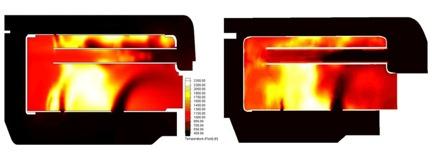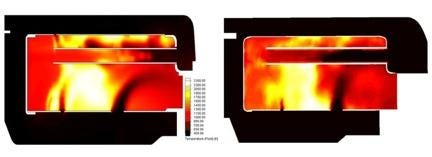January 20, 2015

Internal combustion engines are ruling power generation applications even today, and improvising them to churn out every slice of power is still an area of research for the engineering community. There are many things one can learn about the internal combustion engine through physical tests, such as heating and cooling phenomena, its behavior during vehicle acceleration, maximum power generating capability, torque, fuel consumption, and so on.
However, physical tests have their limitations and are not capable enough to assess the combustion process comprehensively. Although there are several optical engine technologies, which allow an engineer to visualize what's happening inside the engine cylinder, they do have their own complexities. Their configurations are limited, and they are also highly expensive methods that negatively affect research budgets.

Computational Fluid Dynamics for Combustion
Studying a combustion process as it occurs inside the engine is one of the most important ways that help combustion engineers improve overall engine performance. Extracting every Joule of energy from the fuel is what every engineer strives for. While experimental investigations are complex and inaccurate, replicating the flame propagation inside the cylinder through computer aided simulation seems to be the most viable choice.
The use of computational fluid dynamics (CFD) is, as such, getting more intensive in engine analysis, and continuous improvements are being made to improve combustion models for result accuracy. CFD, in general, solves fluid flow problems using governing equations, and it is being extensively applied to study reacting flows in internal combustion engines.
Through the use of species transport and chemical reaction equations, it is possible to simulate the process of combustion right from the first flame front to the exhaust gas formation and every reaction in between. CFD can precisely recreate fuel entrance, mixing, air motion and the combustion reaction to identify critical parameters of the engine that affect its performance.
Related articles on DesignNews.com
It is even possible to establish different engine operating scenarios, such as turning off the heat transfer to see what the engine efficiency could be without heat loss, or eliminating leakage past the piston rings to measure its impact on engine efficiency.
Some of the valuable insights can be obtained more easily, such as the flame front travel and the impact of piston crown design on the combustion process, without actually performing physical examinations. Moreover, there is a possibility to study the amount of emission gases formed at the end of the combustion process, which can assist in enhancing emission control technologies for the designed engine.
Design engineers and professionals, the West Coast's most important design, innovation, and manufacturing event, Pacific Design & Manufacturing, is taking place in Anaheim, Feb. 10-12, 2015. A Design News event, Pacific Design & Manufacturing is your chance to meet qualified suppliers, get hands-on access to the latest technologies, be informed from a world-class conference program, and expand your network. (You might even meet a Design News editor.) Learn more about Pacific Design & Manufacturing here.
Mehul Patel specializes in handling CFD projects for the automobile, aerospace, oil and gas, and building HVAC sectors. He has worked as a CFD consultant with Hi-Tech CFD for the past five years and has successfully executed numerous CFD projects of high complexities. He is an expert in turbo-machinery, gas dynamics, combustion, fluid dynamics, multiphase flow analysis, and computational fluid dynamics.
About the Author(s)
You May Also Like



